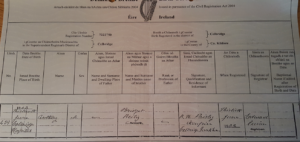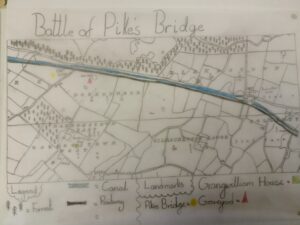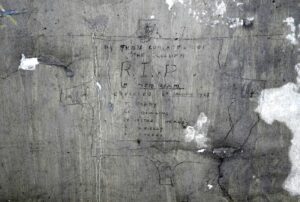This article is transcribed from the Kildare Observer, 19 September 1896
Co. Kildare Archaeological Society
Annual Excursion Meeting
President – Lord Mayo
On last Thursday, the members of the Kildare Archaeological Society held their annual yearly excursion, when the tract of country selected embraced the districts of Celbridge, Leixlip and Lucan, part of he county which are rich with the remains of an antique order of architecture and civilisation, rude though it may have been which at an early period which distinguished our country and made her famous amongst the nations of Europe. Those traces of former grandeur, those seats in which learning was fostered, where the masters taught, where the friar prayed, and where the anchorite passed away his days in silence and devotion, are now almost completely swept away and are only traceable here and there by the presence of a tower, or an arch, or a pillar, which serve as marks to point out the extent of the original building and give us an idea, however faint, of men and days that belong to the far away past. Still are they rich with associations and in their melancholy desolation they speak as it were with tongues of fire and appeal to us here in the close of the 19th century to cast back our minds through the mists of years and think of them in their pristine days when they formed a sanctuary for the refugee and were the great magazines of thought and action, from whose windows burned the bright light of education which illumined the dark cloud of ignorance that then encompassed the land. In those turbulent days when clan made war on clan, when unbridled passion and might rode roughshod over peacefulness and weakness, they formed a centre of counteracting influences to calm fierce spirits and protect the down-trodden from the free vengeance of the victor, for their portals proved, as tradition tells us, a safe haven for the defeated and here the hand of the abbot was more powerful than the sword of the soldier.
To pick up the links of their story and join them one by one into the chain of narrative is the object of this association and surely a more noble or national one it would be impossible to imagine. The names of the founders of those institutions are thus rescued from obscurity and despite the fact that centuries have piled the oblivious years like funeral stones over them, their good intentions and their good acts are brought to light and one feels a sense of genuine admiration for men whose calmness of mind and whose broadness of idea enabled them to leave behind these monuments which even the crumbling hand of time has been unable to wholly efface. But we prefer to let the extracts, which we reproduce from the papers that were read, tell their story as they have been written by able men and with no little attention to the accuracy of fact the closeness of details.
Thursday morning broke in gloomy enough with a most unpleasant rainfall which, however, towards eleven o’clock cleared away and the remainder of the day was fairly fine. Alighting at Hazlehatch Railway Station the entire party drove over some two miles of the Loughlinstown road to St. Wolstan’s, the seat of Major O’Kane, and after a walk of some half a mile reached the first point of the days proceedings at the ruins of the old Abbey. Prior to the reading of the paper dealing with the history of the Abbey, Mr G Mansfield, in a few well chosen sentences, expressed the regret which the members of the Association felt at the death of the Rev. D. Murphy, their vice-president and hon. editor, and a vote of condolence was unanimously voted to his relatives in their bereavement. After the reading of the paper by Mr Kirkpatrick, those present inspected the ruins which consists of two gates and a tower from the latter of which a fine view of the park like scenery may be obtained stretching away in grove and lawn to the right, while to the left the Liffey deep and broad runs its course between banks overhung by a line of noble trees.
After visiting the Scholars’ Well and inspecting a most peculiar structure called the moss house, the frame of which is most rustic supporting a covering of beautiful moss, the party proceeded to Leixlip where a pause was made to view the famous salmon leap, and a most attractive sight it presented. It consists of five layers or ledges of rock placed at irregular intervals, the fourth being the most precipitous, over which the river water swollen by autumn rains into a boiling torrent, rushed with tremendous force until split almost into two halves by a serpentine line of boulders which runs to a small island in the centre of the stream. After some delay Leixlip Castle was next visited, and here great interest was manifested in the different apartments, particularly that known as the “King’s Room.” The castle itself commands a noble view. Away towards the north is a fine panoramic view of lawn and woodland, whilst the river “o’erhung by wild woods thickening green,” rolls outward towards the ocean.
The view from the lofty round tower is particularly fine, and though all was peace and friendliness there on last Thursday, many a fierce hand-to-hand struggle raged round its walls in the feudal days of yore. Leaning over its battlement on that calm autumn evening, the mind’s eye was irresistibly carried back along the avenue of time to the days when the English power was beginning to take root in Ireland, and this keep formed one of its strongholds, one of the bulwarks of the Pale for resisting the incursions of the native clansman. The principal actors in these scenes have long since passed away. The castle, denuded of its portcullis and drawbridge, has been transformed into a comfortable modern residence, and nothing remains of its heroes, it scares and changes but the voice of tradition, which still fondly loves to linger in the corridors of time.
Leaving the castle, the parish church was next visited. The principle tablets being pointed out to the visitors; one being erected to the memory of a member of the white family, and bears the date 1654, and also, strangely enough, two in connection with the Devonshire family. In the centre of the nave is a large flagstone, which tells us that it covers the remains of Dr Price, a former Archbishop of Cashel, who passed hence on the 17th July, 1753, at the ripe age of 74 years. After quitting the church, the party again remounted the cars, and a magnificent drive through Col Vesey’s domain, parallel with the river, brought it to the Lucan Spa Hotel, where luncheon was served; after partaking of which a start was made for Castletown house, the noble family seat of the Connollys, but at present in the occupation of the Lord Chief Justice. Here two interesting papers, dealing specifically with the building and the family, were read; after which his Lordship and her Ladyship kindly showed the visitors over the house.
Donacomper graveyard then claimed attention, and here a brightly written and attractive paper was read by Mr Kirkpatrick. This being finished the part repaired for tea to the residence of the author. Donacomper is an extremely interesting house, occupying a very pretty situation, and containing within its four walls many articles of great interest. On the walls of the drawing room are two splendid specimens of tapestry work, which are of great value. The guests were here most hospitably entertained by Mrs Kirkpatrick, who is a most charming hostess, after which the party dispersed after a most enjoyable day.
Amongst those who took part in the excusion were: – Lady Mayo, Lord and Lady Drogheda; Most Rev Mgr Denis Gargan, President Maynooth College; Rev Dr O’Dea, Vice-President Maynooth College; Mr George Mansfield, D L; Mr M J Synnott, Major and Mrs Rynd, Mr J Loch C I, R I C, Mrs and Dr Woolcombe, Mr Supple, RIC; Mr L Dunne JP; Rev P O’Leary, Maynooth College; Mr and Mrs Green, Mr and Mrs Sweetman, Mr C Molloy, Mr and Mrs Carroll, Mr and Mrs Davidson Houston, Mr A D Cooper, B L; Mr Grove White, Solicitor; Miss Margaret Stokes, Mr W Mooney, Leixlip Castle; Lady Henry Fitzgerald, Lady Eva Fitzgerald, Lady Mabel Fitzgerald, Lord Frederick Fitzgerald, Lord George Fitzgerald, Lord Henry Fitzgerald, Lord Walter Fitzgerald, Lord Desmond Fitzgerald, and the Duke of Leinster, the Lord Chief Justice Sir Peter O’Brien Bart; the Rev L R Somers, Dunboyne; Charles Daly, Esq, Sub-Sheriff, Co. Kildare; Thos. E O’Kelly, M.D., Maynooth; Rev C I Graham, Celbridge; Earl of Drogheda, Countess of Drogheda, Geo. C A Colley, Esq., Dr Norman Bath; — Clarke, Esq., Athgoe Park; William Mooney, Esq. Leixlip Castle; W A Murphy, Osberstown House, Naas.
At St Wolstan’s, before reading the paper, Mr Mansfield said he had been asked, in absence of their president, Lord Mayo, to remind those present that that was to be the first meeting they held since the death of the Rev Father Murphy, who was their vice-president and hon. editor, and one of their first duties would be to pass a resolution of sympathy with his relatives in their sad bereavement. The late Rev gentleman was one of the foremost archaeologists in Ireland, and he had always evinced the greatest interest in their society. They owed a deep debt of gratitude to him, and he felt sure it would be hard to replace him.
The resolution was carried unanimously in silence.
In the course of his paper, Mr Kirkpatrick said the Priory of St Wolstan’s was founded in the year 1202, or according to Ware, 1205, for Canons of the Order of St Victor by Richards, first Prior of the place, and Addin de Hereford in memory of St Wolstan, bishop of Worcester, then newly canonised by Pope Innocent III. The first part of the building was commonly called Sala Coeli, or the Steps of Heaven. De Hereford granted to Richard, the first Prior, the lands on the river Liffey and the church of Donacomper, which had existed before the foundation of the monastery. In 1271, William, seneschal to Fulke, Archbishop of Dublin, granted to the Prior the lands of Castledillon, and increased the number of canons and obliged them to celebrate his own and his wife’s anniversary, on which day they were to feed 30 poor persons or give them instead a penny each under penalty of 100 shillings. In 1310 when Stephen was Prior, Nicholas Taffe gave to this Priory the manor of Donacomper, which was valued at £8 6s 8d yearly, but having been granted without a license it was subsequently seized.



 Anthony O’ Reilly was the only one of these men executed and we wanted to learn more about him. Local historian Jim Doyle has done extensive research on O’ Reilly and he came to speak to us.
Anthony O’ Reilly was the only one of these men executed and we wanted to learn more about him. Local historian Jim Doyle has done extensive research on O’ Reilly and he came to speak to us.

 [ 11]
[ 11]
 [13]
[13]

 “Treachery on the 1st December 1922 in that they at Leixlip assisted certain armed persons in using force against the National troops.”
“Treachery on the 1st December 1922 in that they at Leixlip assisted certain armed persons in using force against the National troops.”


 [26]
[26]


